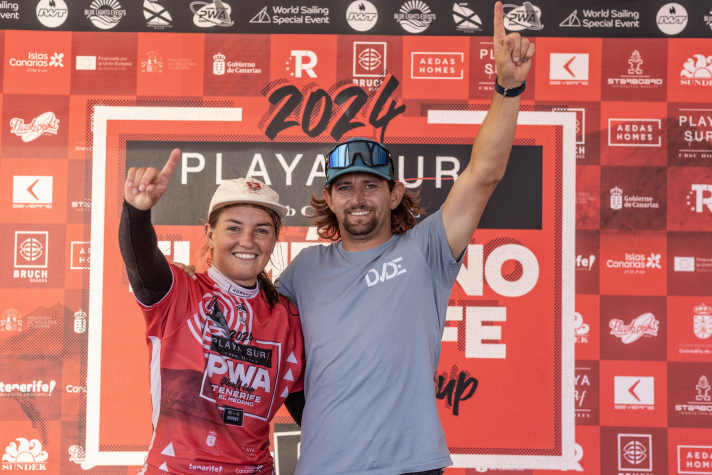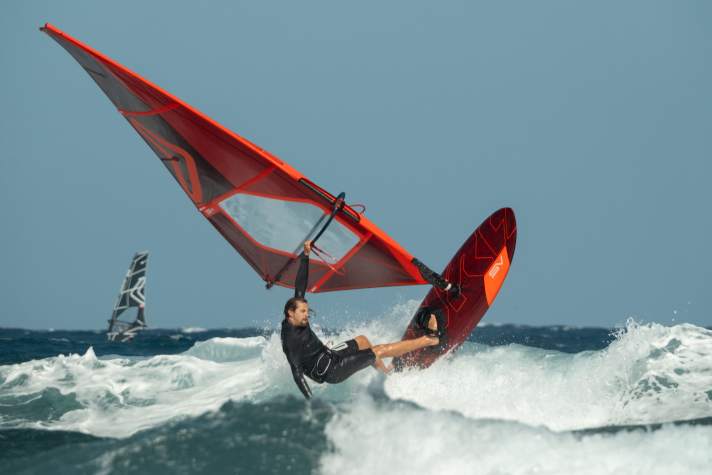World champion, coach and pro: The windsurfing nerd - an interview with Dieter van der Eyken
Julian Wiemar
· 01.03.2025






Hi Dieter, you windsurf full-time. You can say that, can't you?
Yes, that's the case. It's a mixture of my work for Severne, the coaching and the contests I take part in. Windsurfing is my job. I stopped studying in 2012, that was twelve years ago, and I've been a pro ever since.
You coach the top German rider Lina Erpenstein, among others. What does coaching like this look like?
We work on all kinds of things. For example, I try to get them in the best possible mood for the particular spot where the contest is taking place. This works well via walkie-talkie. During the warm-up sessions, I then give them instructions from the beach about positioning on the waves, for example - that way we get them into the right rhythm with the given spot as quickly as possible. We also film and analyse their jumps and rides and draw up a game plan for the heats. Another big part of our collaboration is that I not only support them as much as possible during preparation, but also during the contest. On the one hand, this means caddying, but sometimes also taking decisions and giving instructions by signalling in the heat. The classic in the wave heat: use the remaining time to improve the jump score or go in search of waves?
The concept seems to be working. Lina is now competing at the very top of the World Cup. She wants to become world champion next year.
I always say: coaching accelerates progress. It can't take the learning process away from you, but it can speed it up. In the end, it's Lina herself who gets better and better and realises all the things on the water. That's not just down to me and the coaching. But she says, for example, that it helps her just to have someone on site during the contests who is one hundred per cent behind her and supports her. Knowing that someone is always on the beach with spare equipment or a different size of sail helps a lot.
Coaching accelerates progress. It can't take the learning process away from you, but it can speed it up.
It sounds like you get on well with each other.
Absolutely. And that's also very important, I think. The coaching is on a professional level, but we are also friends and get on very well.
My goal is to win a world title with her!

You breathe windsurfing, don't you? When you're not training for yourself, you're coaching others. You've been competing in the World Cup in freestyle and waves for many years, have a freestyle world championship title, are on the PWA management board...
I go to bed thinking about windsurfing, I wake up thinking about windsurfing (laughs).
That's actually the case, yes, but I love it. Windsurfing is the best sport in the world! I started when I was seven. I wouldn't know what I would do if it wasn't windsurfing - either professionally or as a hobby.
I go to bed and think about windsurfing, I wake up and think about windsurfing.
A few years ago, you travelled from Belgium specifically to El Médano on Tenerife to have a training spot right on the doorstep...
I was looking for a place to live that offered decent windsurfing conditions all year round. Because when I used to live in Belgium, I was travelling nine months a year. At some point, that was just too much. I'm well connected to the rest of Europe from here and have wave and freestyle conditions on my doorstep. That means I don't have to travel that much anymore.
You finished fourth in Pozo this summer. That's a fantastic result. Now, at the latest, no one thinks "only" of freestyle when they hear your name, I assume.
Yes, it took a few years (laughs), about ten. Funnily enough, it was the winter from 2014 to 2015, the winter before I became freestyle world champion, when I really focussed on training in the waves for the first time. It seems like it somehow cleared my head. I used to spend a lot of the winter in Western Australia, where I was able to slowly but steadily improve my level in the waves alongside my freestyle training. The wave discipline is tough, it's the supreme discipline and the competition is bigger. So I'm really happy with my last Pozo result and motivated to keep attacking in the waves.
Many people claim that you are a real windsurfing nerd and have a very analytical approach to the sport. Would you subscribe to that?
Yes, that's one hundred per cent true. I always want to understand everything in detail before I try it out on the water. I therefore analyse movement sequences down to the smallest detail. I did that myself as a child in freestyle. Because if I really understand the manoeuvre, then I can learn it relatively quickly on the water. This not only helps me to learn new manoeuvres and techniques myself, but also to pass them on as a coach and explain them well.
I always want to understand everything in detail before I try it out on the water.
You have a similarly analytical approach to scoring in competition, don't you? It always looks like you know exactly what you want to do in your heats and, above all, what you're missing on the scoresheet to have a chance of winning.
Many drivers don't even take a close look at their scores after the heat. I can't understand that. Remko de Weerd taught me very early on when I was starting out in freestyle to check the scores after every heat - regardless of whether you've won or lost. You can always learn from that. And yes, I have a precise plan in my head before every heat. Maybe it's sometimes boring to watch me because I surf so predictably, but this consistency has often got me far in many contests, especially in difficult conditions.

Does this apply to the freestyle and wave disciplines?
No, not quite, because the unpredictable factor of the wave decides what you can and can't show. If the wave doesn't give you the framework to perform, then being the best waverider in the world won't do you any good. That's why it's so important to choose and catch the right wave, whereas on flat water in freestyle you actually always have control over what you can and can't perform.
I have a precise plan in my head before every heat.
The coaching will certainly also help you to become an even better rider and competitor yourself, for example if you analyse scores and waves in detail with Lina and compete yourself on the same day, right?
That helps me a lot, yes. I could clearly see that this season. When I go into detail with Lina about what the judges want to see at the respective contest and what kind of waves are rated the highest, I automatically have that in my own heats as well. I often have to tell myself a lot of the things I tell her.
When it comes to material, are you more of a nerd?
(Ponders for a long time) I think I still have a lot to learn, let's put it that way. There are definitely more renowned material gurus than me. I pay close attention to my equipment and realise straight away if something is wrong or if something is set differently. But I'm not a fin freak like Marc Paré, for example.
Your most popular coaching camp on Tenerife is called "Intro into Wave", with which you attract many wave beginners from all over Europe to Tenerife every year. Can you tell us one of your top tips for wave beginners?
Choose the right spot and find out about it before you go out on the water. Material breakage on the open sea means something completely different than on a quarry pond. Ask the locals about possible dangers and never go out completely alone. It doesn't have to be 40 knots and mast-high waves, 20 knots and waist-high waves are enough to get a taste for it. It always feels bigger on the water than it looks from the beach. Always keep that in mind.
What would you recommend to someone who doesn't really get the wave flavour because they're struggling too much in the surf?
What I generally notice very often are wave beginners on material that is too small with a sail size that fits well outside, but is one size too small in the surf and current zone to get out easily. So: Choose material that is big enough - better one size too big than too small. Learn to ride a little overpowered out there. And then: grab a wave before you start jumping. Any windsurfer who can ride a jibe can, in principle, also ride a harmless wave. Most people quickly acquire a taste for it.
Any windsurfer who can ride a jibe can, in principle, ride a harmless wave.
What's on your programme this winter?
After my two wave camps in Capetown in January and February, I'm heading back to Tenerife for two camps in March. My aim is to offer a total of ten camps this year, possibly in new locations. You can find all the information on my Website.

